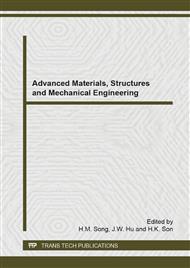[1]
T. Arima, H. Murata and T. Hamada: J. Oral Rehabilitation. Vol. 23, No. 5 (1996), p.346.
Google Scholar
[2]
J.F. McCabe, A.W.G. Walls, editor. Applied Dental Materials. 9th ed. Oxford: Blackwell Publishing Ltd (2008).
Google Scholar
[3]
P.K. Vallittu: J Prosthodont. Vol. 5, No. 3 (1996), p.186.
Google Scholar
[4]
E.A. Ayaz and R. Durkan: Inter. J. Oral Sci. Vol. 5 (2013), p.229.
Google Scholar
[5]
D. Arnold et al.: J. Prosthetic Dentistry Vol. 100, No. 1 (2008), p.47.
Google Scholar
[6]
O.B. William: J. editor. Dental Materials and Their Selection. 4th ed. Hanover Park, IL, USA: Quintessence Publishing Co, Inc; (2008).
Google Scholar
[7]
R.P. William and W. Henry: Fields, David M. Sarver. Contemporary Orthodontics. 5th ed. Elsevier Mosby Inc; St. Louis, USA; (2013).
Google Scholar
[8]
C. Charles E., Jr., editor. Introduction to Polymer Chemistry. 2nded. CRC Press Taylor&Francis Group, LLC; (2010).
Google Scholar
[9]
B.W. Darvell, editor. Materials Science for Dentistry. 9th ed. Cambridge: WoodheadPublishing Ltd; (2009).
Google Scholar
[10]
ISO 20795-2 Dentistry- Base polymers- Part 2: Orthodontic base polymers. International Organization for Standardization. (2010).
Google Scholar
[11]
S. Nick, A. Abdulaziz and C.W. David: Influence of P/L ratio and peroxide/amine concentrations on shrinkage-strain kinetics during setting of PMMA/MMA biomaterial formulations. Biomaterials. Vol. 26 (2005), p.197.
DOI: 10.1016/j.biomaterials.2004.02.028
Google Scholar
[12]
T. Arima, H. Murata and T. Hamada: J. Prosthet Dent. Vol. 73, No. 1 (1995), p.55.
Google Scholar
[13]
D.R. Beech: J. Dent. Vol. 3, No. 1 (1974), p.19.
Google Scholar
[14]
T Saen-isara et al.: Adv. Mater. Res. Vol. 726 (2013), p.303.
Google Scholar
[15]
C. Machado, E. Sanchez and S.S. Azer: J. Dentistry. Vol. 35, No. 12 (2007), p.930.
Google Scholar
[16]
R.V. Noort: Introduction to dental materials. 3rd ed. London: Elsevier Limited; (2007).
Google Scholar
[17]
A. Gross: Is the use of cold curing polymers justifiable in the production of definitive dentures Quint Dent Tech. Vol. 1 (1976), p.11.
Google Scholar
[18]
E. Rose, J. Lal and R. Green: J. Am. Dent. Assoc. Vol. 56 (1985), p.375.
Google Scholar


